Unit 8 Our Clothes Topic 1 Section D课件(共24张PPT)仁爱版八年级下册
文档属性
| 名称 | Unit 8 Our Clothes Topic 1 Section D课件(共24张PPT)仁爱版八年级下册 | 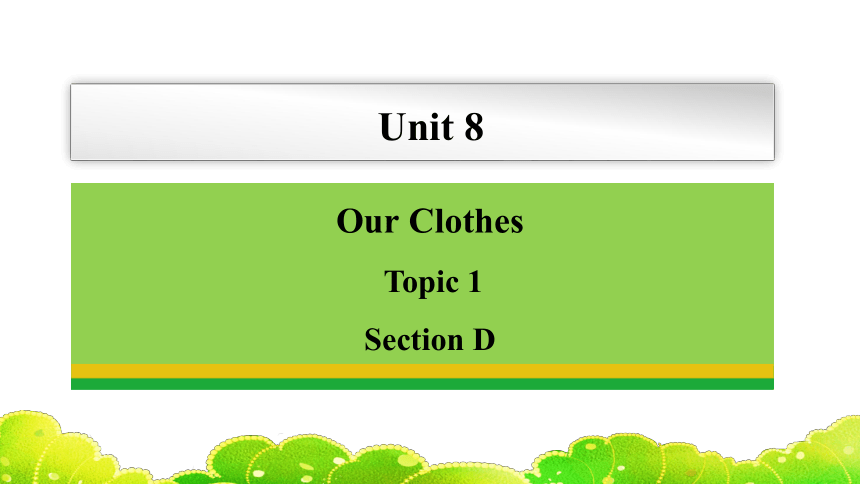 | |
| 格式 | pptx | ||
| 文件大小 | 2.4MB | ||
| 资源类型 | 教案 | ||
| 版本资源 | 仁爱科普版 | ||
| 科目 | 英语 | ||
| 更新时间 | 2024-03-24 21:18:29 | ||
图片预览


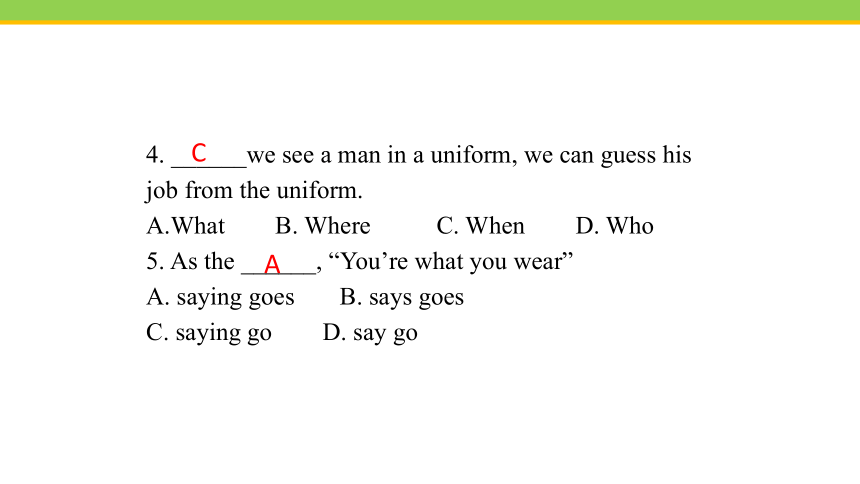
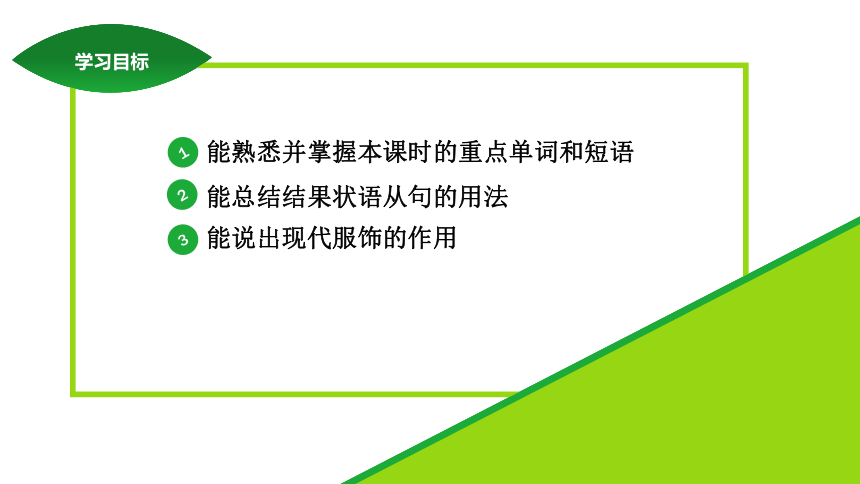

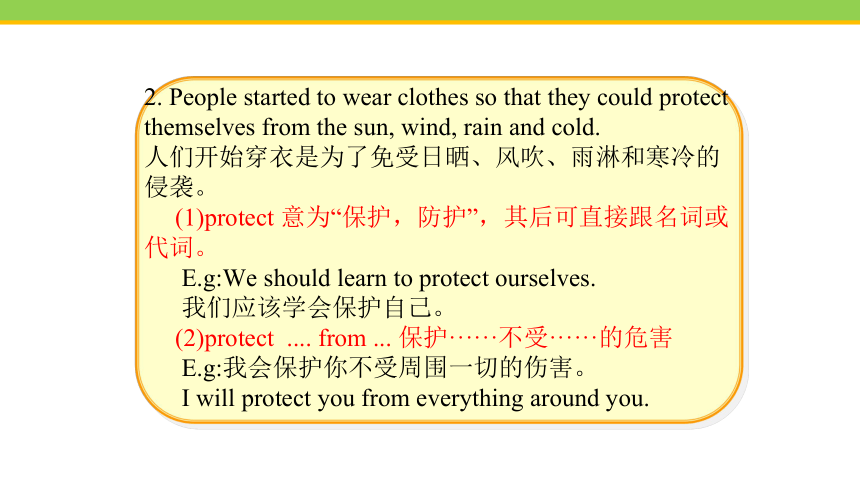
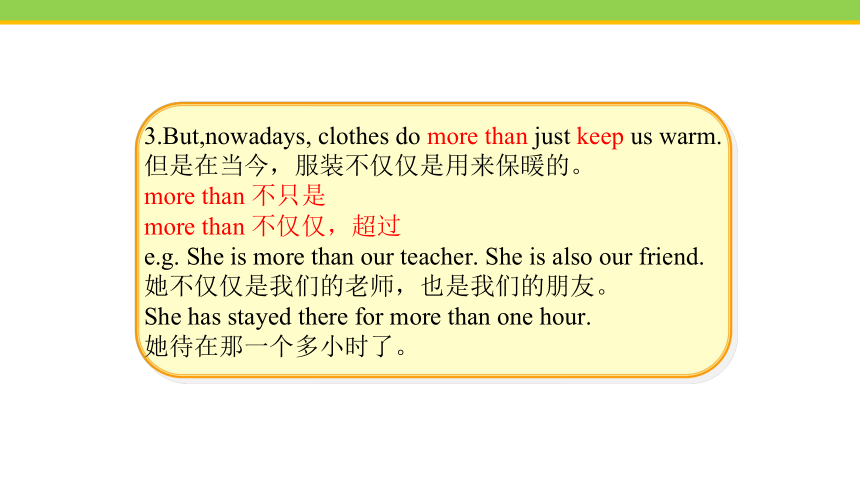
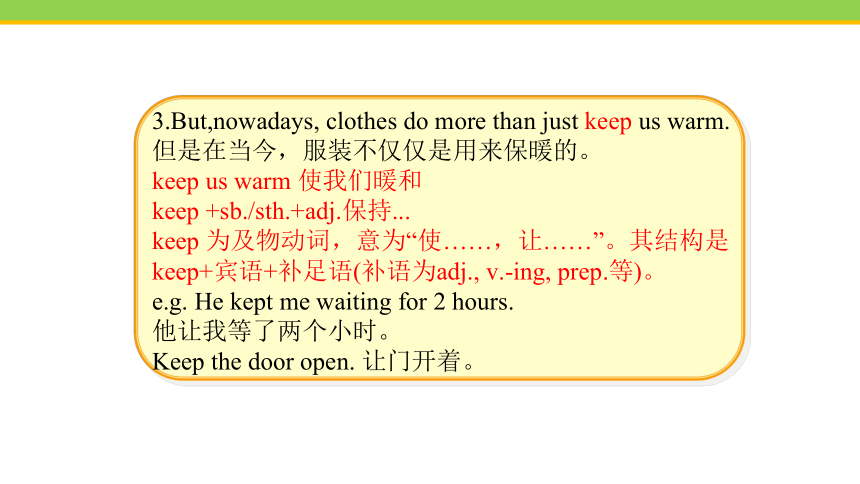
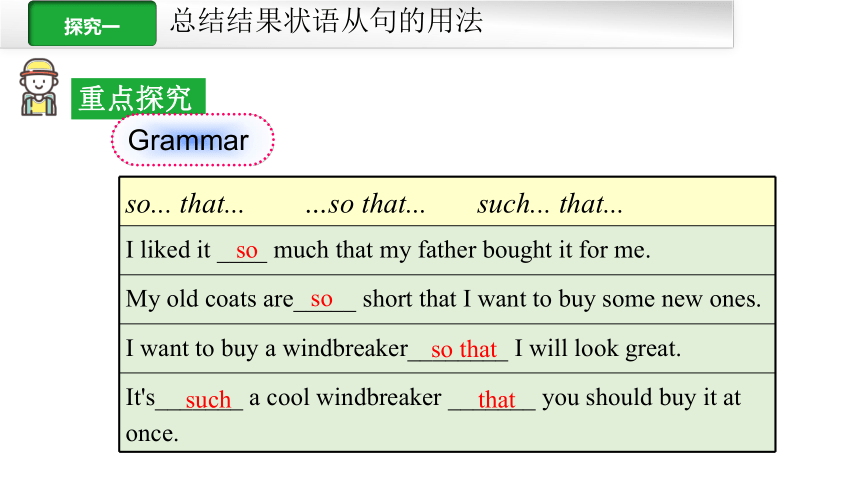
文档简介
(共24张PPT)
Unit 8
Our Clothes
Topic 1
Section D
1. If a man always wears sportswear, we may think he is active and ______ doing exercise.
A. likes B. like C. dislikes D. unlike
2. She ______ she ______ like it at all.
A. say, didn’t B. said, didn’t
C. said, don’t D. say, did
3. He said the fashion show ______ wonderful.
A. be B. were C. is D. was
A
B
D
预习检测
4. ______we see a man in a uniform, we can guess his job from the uniform.
A.What B. Where C. When D. Who
5. As the ______, “You’re what you wear”
A. saying goes B. says goes
C. saying go D. say go
C
A
能熟悉并掌握本课时的重点单词和短语
1
2
3
能总结结果状语从句的用法
能说出现代服饰的作用
知识梳理
1.The first types of clothes were made of animal skins.
be made of... 由......制成(从表面可看出原材料)
be made from... 由......制成(从表面看不出原材料)
E.g:这张桌子是由木头制成的。
The desk is made of wood.
纸是由木材制成的。
Paper is made from wood.
2. People started to wear clothes so that they could protect themselves from the sun, wind, rain and cold.
人们开始穿衣是为了免受日晒、风吹、雨淋和寒冷的侵袭。
(1)protect 意为“保护,防护”,其后可直接跟名词或代词。
E.g:We should learn to protect ourselves.
我们应该学会保护自己。
(2)protect .... from ... 保护······不受······的危害
E.g:我会保护你不受周围一切的伤害。
I will protect you from everything around you.
3.But,nowadays, clothes do more than just keep us warm.
但是在当今,服装不仅仅是用来保暖的。
more than 不只是
more than 不仅仅,超过
e.g. She is more than our teacher. She is also our friend.
她不仅仅是我们的老师,也是我们的朋友。
She has stayed there for more than one hour.
她待在那一个多小时了。
3.But,nowadays, clothes do more than just keep us warm.
但是在当今,服装不仅仅是用来保暖的。
keep us warm 使我们暖和
keep +sb./sth.+adj.保持...
keep 为及物动词,意为“使……,让……”。其结构是keep+宾语+补足语(补语为adj., v.-ing, prep.等)。
e.g. He kept me waiting for 2 hours.
他让我等了两个小时。
Keep the door open. 让门开着。
总结结果状语从句的用法
重点探究
so... that... …so that... such... that...
I liked it ____ much that my father bought it for me.
My old coats are_____ short that I want to buy some new ones.
I want to buy a windbreaker________ I will look great.
It's_______ a cool windbreaker _______ you should buy it at once.
Grammar
so
so
so that
such
that
知
识
总结
such...that 与so...that的区别:
so后接形容词或副词,such后接名词。但如果名词前有表示数量多少的形容词many, much, few, little修饰时,则要用so,而不用such。
e.g. There were so few people on the street that the street seemed lonely.
街上没几个人,显得冷清。
另外“such+a(n)形容词+名词单数”也可换成“so+形容词+a(n)+名词单数”。
e.g. Mr. Miller is such a busy man/so busy a man that he can’t leave his office.
米勒先生是个大忙人,离不开办公室。
Functions
Shall we meet at the school gate at 8:00 a.m
All _________.
Excuse me,_______ you tell me where to buy a scarf
What size do you take _________ M.
right
could
Size
Look at the pictures and guess about the people based on what they wear. Then read and check your ideas.
The policeman is wearing uniforms.
She is in a kimono,
maybe she is Japanese.
He is wearing sportswear.
She is wearing school uniforms.
Discussion
The first types of clothes were made of animal skins. People started to wear clothes so that they could protect themselves from the sun, wind, rain and cold.
Today, we use different materials to make different kinds of clothes. But nowadays, clothes do more than just keep us warm. Clothing can also show people our jobs, our culture, our hobbies and even our moods.
1a Read and understand.
For example, when we see a man in a uniform, we can guess his job from the uniform. When we see a woman in a kimono, we may think that she is Japanese. If a man always wears sportswear, we may think he is active and likes doing exercise. If a person always wears yellow or pink clothes, maybe he or she is lively and easy-going. We get ideas about people from their clothes. As the saying goes, “You are what you wear.”
Finding key words of the question in the passage can help you to comprehend quickly.
1b Read again and complete the following tasks.
1. What does the passage mainly talk about
A. The history of clothes. B. The functions of clothes.
C. The styles of clothes. D. The types of clothes.
2. Which of the following is true
A. People wore the first types of clothes to show fashion.
B. Nowadays, clothes not only keep us warm.
C. Clothes can tell what your names are.
D. People almost wear the same kind of clothes now.
√
√
3. When we see a woman in a kimono,we might think she is ___________.
4. If a man always wears sportswear,we may think he is __________________________.
5. If a person always wears yellow clothes,maybe he or she is ___________________.
Japanese
active and likes doing exercise
lively and easy-going
6. Work in groups and discuss the meanings of the following sentences.
1) Clothes can also show people our jobs, our culture, our hobbies and even our moods.
2) You are what you wear.
discuss v.讨论,谈论
Group Work
衣如其人。
衣服也可以向人们展示我们的工作,我们的文化,我们的爱好,甚至我们的心情。
Describe the clothes you are wearing today. The following questions may help you.
What are you wearing today
What color/size ... are your clothes
What materials are they made of
What do you think of them
Example:
I’m wearing a white T-shirt today. The size is M. It is made of cotton. My jeans are blue. They are made of cotton, too. I like this kind of white sports shoes. They are made of leather and they are size 37. My clothes are very comfortable. They make me active.
Free Talk
1.Survey your classmates about their favorite clothes and fill in the table.
Name Clothing Color Size Material
Li Xing T-shirt white M cotton
Do a survey
2.Discuss whether your classmates' dressing is suitable or not. Give your suggestions.
3.Write a report and present it to the class.
so …that … 2.形容词或副词 3. 从句 4. 时态、语序、引导词
活动小结
通过上述活动,我们可以知道:so后接1._____________,such后接2._____。但如果名词前有表示数量多少的形容词many, much, few, little修饰时,则要用3._____,而不用4._____。
形容词或副词
名词
such
so
当堂检测
1. 在冬天穿毛衣可保暖。
Sweater can _____ ____ _____ in winter.
2. 太阳镜能保护我们的眼睛不受阳光的侵害。
The sunglasses can _______ _____ _____ _____ the sunshine.
3. 俗话说,“人乡随俗”。
_____ the saying _____, “Do in Rome as the Romans do.”
4.当我们到三年级时,有超过六科的课程。
We’ll have _____ _____ ____ ______ when we are in Grade 3.
5. 单词“kimono”是什么意思?
_____ _____ ________ of the word “kimono”
一、根据汉语提示完成句子。
keep us warm
protect our eyes from
As goes
more than six subjects
What’s the meaning
课堂总结
Unit 8 Topic 1
Section D
重点单词:
skin, uniform, kimono, sportswear, easy-going, saying, material, function,
重点短语:
be made of/from
protect...from...
so...that...
so that
such...that...
so…that…和such…that…引导的结果状语从句:
Unit 8
Our Clothes
Topic 1
Section D
1. If a man always wears sportswear, we may think he is active and ______ doing exercise.
A. likes B. like C. dislikes D. unlike
2. She ______ she ______ like it at all.
A. say, didn’t B. said, didn’t
C. said, don’t D. say, did
3. He said the fashion show ______ wonderful.
A. be B. were C. is D. was
A
B
D
预习检测
4. ______we see a man in a uniform, we can guess his job from the uniform.
A.What B. Where C. When D. Who
5. As the ______, “You’re what you wear”
A. saying goes B. says goes
C. saying go D. say go
C
A
能熟悉并掌握本课时的重点单词和短语
1
2
3
能总结结果状语从句的用法
能说出现代服饰的作用
知识梳理
1.The first types of clothes were made of animal skins.
be made of... 由......制成(从表面可看出原材料)
be made from... 由......制成(从表面看不出原材料)
E.g:这张桌子是由木头制成的。
The desk is made of wood.
纸是由木材制成的。
Paper is made from wood.
2. People started to wear clothes so that they could protect themselves from the sun, wind, rain and cold.
人们开始穿衣是为了免受日晒、风吹、雨淋和寒冷的侵袭。
(1)protect 意为“保护,防护”,其后可直接跟名词或代词。
E.g:We should learn to protect ourselves.
我们应该学会保护自己。
(2)protect .... from ... 保护······不受······的危害
E.g:我会保护你不受周围一切的伤害。
I will protect you from everything around you.
3.But,nowadays, clothes do more than just keep us warm.
但是在当今,服装不仅仅是用来保暖的。
more than 不只是
more than 不仅仅,超过
e.g. She is more than our teacher. She is also our friend.
她不仅仅是我们的老师,也是我们的朋友。
She has stayed there for more than one hour.
她待在那一个多小时了。
3.But,nowadays, clothes do more than just keep us warm.
但是在当今,服装不仅仅是用来保暖的。
keep us warm 使我们暖和
keep +sb./sth.+adj.保持...
keep 为及物动词,意为“使……,让……”。其结构是keep+宾语+补足语(补语为adj., v.-ing, prep.等)。
e.g. He kept me waiting for 2 hours.
他让我等了两个小时。
Keep the door open. 让门开着。
总结结果状语从句的用法
重点探究
so... that... …so that... such... that...
I liked it ____ much that my father bought it for me.
My old coats are_____ short that I want to buy some new ones.
I want to buy a windbreaker________ I will look great.
It's_______ a cool windbreaker _______ you should buy it at once.
Grammar
so
so
so that
such
that
知
识
总结
such...that 与so...that的区别:
so后接形容词或副词,such后接名词。但如果名词前有表示数量多少的形容词many, much, few, little修饰时,则要用so,而不用such。
e.g. There were so few people on the street that the street seemed lonely.
街上没几个人,显得冷清。
另外“such+a(n)形容词+名词单数”也可换成“so+形容词+a(n)+名词单数”。
e.g. Mr. Miller is such a busy man/so busy a man that he can’t leave his office.
米勒先生是个大忙人,离不开办公室。
Functions
Shall we meet at the school gate at 8:00 a.m
All _________.
Excuse me,_______ you tell me where to buy a scarf
What size do you take _________ M.
right
could
Size
Look at the pictures and guess about the people based on what they wear. Then read and check your ideas.
The policeman is wearing uniforms.
She is in a kimono,
maybe she is Japanese.
He is wearing sportswear.
She is wearing school uniforms.
Discussion
The first types of clothes were made of animal skins. People started to wear clothes so that they could protect themselves from the sun, wind, rain and cold.
Today, we use different materials to make different kinds of clothes. But nowadays, clothes do more than just keep us warm. Clothing can also show people our jobs, our culture, our hobbies and even our moods.
1a Read and understand.
For example, when we see a man in a uniform, we can guess his job from the uniform. When we see a woman in a kimono, we may think that she is Japanese. If a man always wears sportswear, we may think he is active and likes doing exercise. If a person always wears yellow or pink clothes, maybe he or she is lively and easy-going. We get ideas about people from their clothes. As the saying goes, “You are what you wear.”
Finding key words of the question in the passage can help you to comprehend quickly.
1b Read again and complete the following tasks.
1. What does the passage mainly talk about
A. The history of clothes. B. The functions of clothes.
C. The styles of clothes. D. The types of clothes.
2. Which of the following is true
A. People wore the first types of clothes to show fashion.
B. Nowadays, clothes not only keep us warm.
C. Clothes can tell what your names are.
D. People almost wear the same kind of clothes now.
√
√
3. When we see a woman in a kimono,we might think she is ___________.
4. If a man always wears sportswear,we may think he is __________________________.
5. If a person always wears yellow clothes,maybe he or she is ___________________.
Japanese
active and likes doing exercise
lively and easy-going
6. Work in groups and discuss the meanings of the following sentences.
1) Clothes can also show people our jobs, our culture, our hobbies and even our moods.
2) You are what you wear.
discuss v.讨论,谈论
Group Work
衣如其人。
衣服也可以向人们展示我们的工作,我们的文化,我们的爱好,甚至我们的心情。
Describe the clothes you are wearing today. The following questions may help you.
What are you wearing today
What color/size ... are your clothes
What materials are they made of
What do you think of them
Example:
I’m wearing a white T-shirt today. The size is M. It is made of cotton. My jeans are blue. They are made of cotton, too. I like this kind of white sports shoes. They are made of leather and they are size 37. My clothes are very comfortable. They make me active.
Free Talk
1.Survey your classmates about their favorite clothes and fill in the table.
Name Clothing Color Size Material
Li Xing T-shirt white M cotton
Do a survey
2.Discuss whether your classmates' dressing is suitable or not. Give your suggestions.
3.Write a report and present it to the class.
so …that … 2.形容词或副词 3. 从句 4. 时态、语序、引导词
活动小结
通过上述活动,我们可以知道:so后接1._____________,such后接2._____。但如果名词前有表示数量多少的形容词many, much, few, little修饰时,则要用3._____,而不用4._____。
形容词或副词
名词
such
so
当堂检测
1. 在冬天穿毛衣可保暖。
Sweater can _____ ____ _____ in winter.
2. 太阳镜能保护我们的眼睛不受阳光的侵害。
The sunglasses can _______ _____ _____ _____ the sunshine.
3. 俗话说,“人乡随俗”。
_____ the saying _____, “Do in Rome as the Romans do.”
4.当我们到三年级时,有超过六科的课程。
We’ll have _____ _____ ____ ______ when we are in Grade 3.
5. 单词“kimono”是什么意思?
_____ _____ ________ of the word “kimono”
一、根据汉语提示完成句子。
keep us warm
protect our eyes from
As goes
more than six subjects
What’s the meaning
课堂总结
Unit 8 Topic 1
Section D
重点单词:
skin, uniform, kimono, sportswear, easy-going, saying, material, function,
重点短语:
be made of/from
protect...from...
so...that...
so that
such...that...
so…that…和such…that…引导的结果状语从句:
同课章节目录
- Unit 5 Feeling excited
- Topic 1 You look excited
- Topic 2 I’m feeling better now.
- Topic 3 Many things can affect our feelings.
- Unit 6 Enjoying Cycling
- Topic 1 We're going on a three-day visit to Mount
- Topic 2 How about exploring Tian’anmen Square?
- Topic 3 Bicycle riding is good exercise.
- Unit 7 Food festival
- Topic 1 We’re preparing for a food festival.
- Topic 2 I’m not sure whether I can cook it well.
- Topic 3 I Cooked the Most Successfully
- Unit 8 Our Clothes
- Topic 1 We will have a class fashion show.
- Topic 2 We can design our own uniforms.
- Topic 3 He said the fashion show was wonderful.
